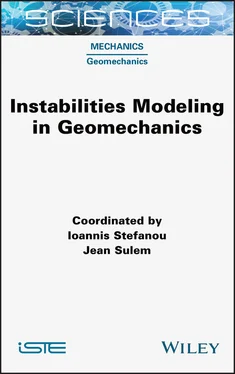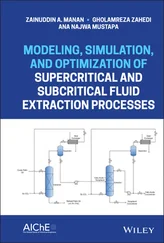Jean Sulem - Instabilities Modeling in Geomechanics
Здесь есть возможность читать онлайн «Jean Sulem - Instabilities Modeling in Geomechanics» — ознакомительный отрывок электронной книги совершенно бесплатно, а после прочтения отрывка купить полную версию. В некоторых случаях можно слушать аудио, скачать через торрент в формате fb2 и присутствует краткое содержание. Жанр: unrecognised, на английском языке. Описание произведения, (предисловие) а так же отзывы посетителей доступны на портале библиотеки ЛибКат.
- Название:Instabilities Modeling in Geomechanics
- Автор:
- Жанр:
- Год:неизвестен
- ISBN:нет данных
- Рейтинг книги:3 / 5. Голосов: 1
-
Избранное:Добавить в избранное
- Отзывы:
-
Ваша оценка:
- 60
- 1
- 2
- 3
- 4
- 5
Instabilities Modeling in Geomechanics: краткое содержание, описание и аннотация
Предлагаем к чтению аннотацию, описание, краткое содержание или предисловие (зависит от того, что написал сам автор книги «Instabilities Modeling in Geomechanics»). Если вы не нашли необходимую информацию о книге — напишите в комментариях, мы постараемся отыскать её.
Instabilities Modeling in Geomechanics — читать онлайн ознакомительный отрывок
Ниже представлен текст книги, разбитый по страницам. Система сохранения места последней прочитанной страницы, позволяет с удобством читать онлайн бесплатно книгу «Instabilities Modeling in Geomechanics», без необходимости каждый раз заново искать на чём Вы остановились. Поставьте закладку, и сможете в любой момент перейти на страницу, на которой закончили чтение.
Интервал:
Закладка:
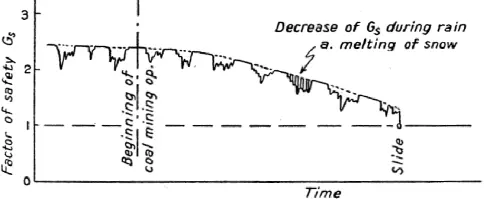
Figure 1.13. Evolution of factor of safety of the slope at Mount Turtle along the process of soil weathering (from Terzaghi 1950)
Sensitivity of basic mechanical properties to chemical processes in the environment has been seen as a critical factor of the stability of slopes and coastal structures due to several processes. These include: cyclic changes in the salinity and acidity of pore water, heat effect due to frictional slip during a creep phase of slope instability, oxidation and dissolution of sandstone, dissolution of calcite, dissolution of silica in aging sediments and dissolution of gypsum in abandoned mines, to mention just a few examples.
The conclusion from the above considerations, in slightly more modern terms, is that a proper approach to a realistic evaluation of FOS would be to view the stability as a scenario composed of several processes coupled between them. These processes would be solid and fluid mechanical as well as geochemical, coupled through both balance equations (including exchanges) and constitutive (phenomenological) coupling, i.e. reactions versus porosity (permeability) versus elasticity or softening. The processes may be either simultaneous or sequential. Hence, the evaluation of the instability of such processes or the differential equations describing them should be approached accordingly, as instability either of the whole process or of any element of the sequence.
An example of such an approach proposed by Veveakis et al . (2007) is an analysis of Vajont dam landslide of 1963 in Northern Italy ( Figure 1.14). This was one of the largest disasters of this sort in the previous century, killing nearly 2,000 people in a town below the dam (which survived). In their analysis, Veveakis et al . postulated that 2–3 years prior to the collapse, creep of the rock mass localized in a clay-rich layer was self-alimented by shear-generated heat, pressurizing and possibly vaporizing water within the layer, and thus leading to thermal softening of clay and accelerating the creep, eventually leading to the massive landslide.
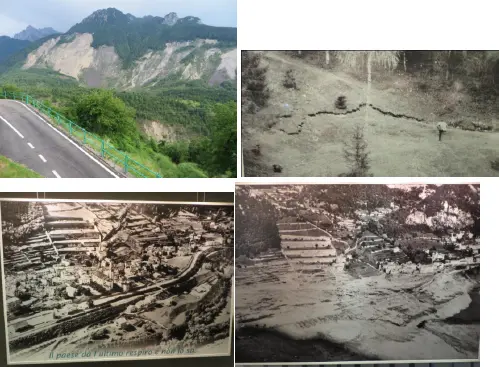
Figure 1.14. Top left: view of the landslide scarp (2014). Top right: a crack (50–100 cm across, 2 km long) that developed parallel to the reservoir shore a few months before the collapse. Bottom: the town of Longarone 2 km below the dam, before (left) and after (right) the tragedy
They calibrated their model against the data from the site at 35°C temperature and 2.5 MPa increase in pore pressure, which were sufficient to produce a creep of velocity 20 cm/day, prior to the failure ( Figure 1.15).
The model has subsequently been generalized to a thermo-plasticity simulation by Cecinato et al . (2011).

Figure 1.15. Top: predicted tempearture and excess pore pressure arising in the shear band during sliding against time (seconds). Bottom: calculated velocity of creep against time in months, compared to other assessments (from Veveakis et al. 2007)
In a similar spirit, a case study of two landslide slip surfaces at Diao Jiao Zui and Qian Jiang Ping sites in the Three Gorges area, China, has been undertaken using a multiphysics approach. Geochemical testing revealed that due to acid rain (with pH between 5.4 and 3.45), potassium ions at the slide surface were released, the cementation was reduced and the ratio of interlayer clay minerals evolved. Accordingly, illite or montmorillonite–illite mixtures were transformed first into kaolinite and subsequently into montmorillonite associated with a complex chemical softening evolution, including a 30% drop in shear strength at the slide surface, but not at a close vicinity (Zhao et al . 2011). Interestingly, both effective internal friction angle and cohesion appear for remolded smectite samples to be non- monotonic functions of time ( Figure 1.16).
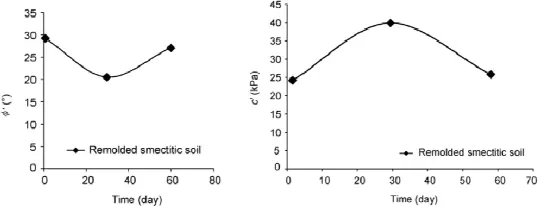
Figure 1.16. Evolution with time of the effective internal friction angle and cohesion during laboratory-simulated chemical transformation due to increase in the pore water pH of a model smectite soil corresponding to the slip surface at Diao Jiao Zui and Qian Jiang Ping sites in the Three Gorges area, China (from Zhang et al. 2015)
In a similar direction of chemo-mechanical coupling at the slide surface, an interesting extension of their thermal runaway creep instability developed for Vajont simulation was proposed by Veveakis et al . (2010). They postulated that the aforementioned frictional motion is affected by not only the generated heat, but also the strain rate. It appears that steady-state heat diffusion across the shear band may be unstable and lead to localization of heat dissipation (and hence thermal softening) at the center of the band. Hence, the authors consider the effect of localized dissipation on endothermic chemical reactions, leading to a variety of possibilities depending on the nature of the specific chemical reaction.
In an analogous spirit, Stefanou and Sulem (2015) investigated the conditions of chemically induced compaction band instability via a chemo-plasticity model.
1.5.2. Thermal pressurization problem
One of concerns in the technology of nuclear waste disposal in clays is the effect of the heat of nuclear decay on the mechanical behavior of clay as a supporting medium surrounding the heat source. One of the multiphysics effects results from a huge difference between the thermal expansion of pore water and thermal expansion of clay (or thermal contraction, depending on whether it is in elastic or plastic range). Laboratory experiments have shown that undrained heating at constant total stress loading conditions relevant to the technology leads to instability at a temperature between 70 and 90°C, as can be seen from the effective stress path in Figure 1.17(a) (Hueckel and Pellegrini 1991).
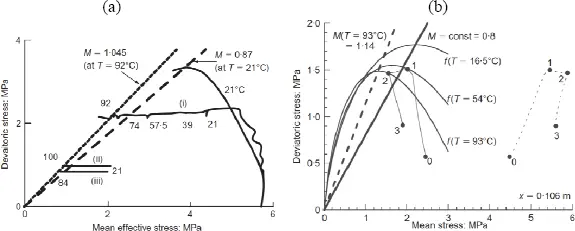
Figure 1.17. (a) Effective stress paths during undrained heating of Boom clay (Hueckel and Pellegrini 1991). Notably the thermally generated pore pressure caused the effective stress to reach values where their further decrement is statically inadmissible (see section 1.3). This can be compared to Figure 1.10. (b) Simulation of the effective stress path and yield locus evolution for a centrally heated (from 16 to 93° C) Boom clay around an axisymmetric borehole with an increase in the critical state parameter of around 43% (from Hueckel et al. 2011)
In a borehole boundary value problem, the problem is exacerbated by the very low permeability of clay, compared to thermal conductivity. Indeed, the effective stress path up to the 0.5 m vicinity of the waste canister approaches the critical states in both considered cases of constant and variable friction angle ( Figure 1.17(b); Hueckel et al . 2011). As the thermo-elasto-plastic deformation is coupled with heat flow and hydraulic flow, its stability and uniqueness should result from consideration of all three fields.
Читать дальшеИнтервал:
Закладка:
Похожие книги на «Instabilities Modeling in Geomechanics»
Представляем Вашему вниманию похожие книги на «Instabilities Modeling in Geomechanics» списком для выбора. Мы отобрали схожую по названию и смыслу литературу в надежде предоставить читателям больше вариантов отыскать новые, интересные, ещё непрочитанные произведения.
Обсуждение, отзывы о книге «Instabilities Modeling in Geomechanics» и просто собственные мнения читателей. Оставьте ваши комментарии, напишите, что Вы думаете о произведении, его смысле или главных героях. Укажите что конкретно понравилось, а что нет, и почему Вы так считаете.
